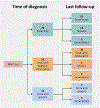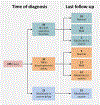A tale of two cohorts: Differing outcomes in infantile-onset focal epilepsy
- PMID: 35146752
- PMCID: PMC9007856
- DOI: 10.1111/epi.17181
A tale of two cohorts: Differing outcomes in infantile-onset focal epilepsy
Abstract
Objective: Infants with focal-onset epilepsy are an understudied population, requiring additional evaluation for clinical assessment and prognostication. Our goal was to characterize the etiology and natural history of infantile-onset focal epilepsy.
Methods: We retrospectively identified all infants (0-24 months) with onset of focal epilepsy while resident in Olmsted County, Minnesota, between 1980 and 2018, using the Rochester Epidemiology Project Database. We assessed the impact of etiology on both seizure and neurodevelopmental outcome, and mortality.
Results: Of 686 children with epilepsy onset <18 years, 125 (18.2%) presented with focal-onset seizures in infancy. Median follow-up for this group was 10.9 years (interquartile range [IQR] 6.2, 19.3). Etiology was identified in 65.6% (structural N = 62, genetic N = 13, both structural and genetic N = 3, metabolic N = 4). Of 107 patients followed >2 years, 38 (35.5%) developed drug-resistant epilepsy (DRE). DRE was more likely with younger age at onset, known etiology, and presence of epileptic spasms. Sixty-eight (63.0% of those with follow-up) were developmentally delayed at last follow-up, and known etiology, DRE, and presence of epileptic spasms were significantly associated with delay (p < .001 for all). Fifteen patients (12.0%) died at a median age of 7.1 years (IQR 1.7, 21.7), but only one death was seizure related (suspected sudden unexpected death in epilepsy [SUDEP]). Of 20 infants with normal development at onset and no known etiology with >2 years follow-up, none developed DRE, all were seizure-free at last follow-up (95% off antiseizure medications [ASMs]), and all remained developmentally normal.
Significance: Infantile-onset focal epilepsy accounts for 18% of all epilepsy in childhood, is frequently due to known etiologies, and has a high rate of DRE. However, developmentally normal infants without a known cause appear to have a very favorable course.
Keywords: epilepsy; focal epilepsy; infantile; infantile spasms.
© 2022 International League Against Epilepsy.
Conflict of interest statement
Disclosures
E Wirrell has served as a paid consultant for Encoded Therapeutics and Biomarin. She is the Editor-in-Chief of
E Triplet, K Nickels, L Wong-Kisiel and A Fine have no conflicts of interest.
Figures




Comment in
-
A Muddy Crystal Ball for Infantile-Onset Epilepsy Outcomes.Epilepsy Curr. 2022 Sep 19;22(6):342-344. doi: 10.1177/15357597221123901. eCollection 2022 Nov-Dec. Epilepsy Curr. 2022. PMID: 36426178 Free PMC article. No abstract available.
Similar articles
-
Epilepsies with onset during the first year of life: A prospective study on syndromes, etiologies, and outcomes.Epilepsia Open. 2024 Aug;9(4):1393-1405. doi: 10.1002/epi4.12966. Epub 2024 May 24. Epilepsia Open. 2024. PMID: 38785332 Free PMC article.
-
Evaluating the effectiveness of medical therapy in infantile epileptic spasms syndrome due to surgically-remediable lesions.Epilepsia. 2025 May;66(5):1433-1446. doi: 10.1111/epi.18291. Epub 2025 Feb 13. Epilepsia. 2025. PMID: 39945474
-
Predictors of medical intractability in children with epilepsy onset during the first two years of life, excluding infantile epileptic spasm syndrome.Seizure. 2024 Apr;117:206-212. doi: 10.1016/j.seizure.2024.03.005. Epub 2024 Mar 9. Seizure. 2024. PMID: 38479206
-
Summary of recommendations for the management of infantile seizures: Task Force Report for the ILAE Commission of Pediatrics.Epilepsia. 2015 Aug;56(8):1185-97. doi: 10.1111/epi.13057. Epub 2015 Jun 30. Epilepsia. 2015. PMID: 26122601 Review.
-
Before the first seizure: The developmental imprint of infant epilepsy on neurodevelopment.Rev Neurol (Paris). 2023 Apr;179(4):330-336. doi: 10.1016/j.neurol.2023.01.725. Epub 2023 Mar 10. Rev Neurol (Paris). 2023. PMID: 36907712 Review.
Cited by
-
CDKL5 deficiency disorder and other infantile-onset genetic epilepsies.Dev Med Child Neurol. 2024 Apr;66(4):456-468. doi: 10.1111/dmcn.15747. Epub 2023 Sep 28. Dev Med Child Neurol. 2024. PMID: 37771170 Free PMC article.
-
Outcome at age 7 of epilepsy presenting in the first 2 years of life. A population-based study.Epilepsia. 2022 Aug;63(8):2096-2107. doi: 10.1111/epi.17314. Epub 2022 Jun 25. Epilepsia. 2022. PMID: 35652437 Free PMC article.
-
Epilepsies with onset during the first year of life: A prospective study on syndromes, etiologies, and outcomes.Epilepsia Open. 2024 Aug;9(4):1393-1405. doi: 10.1002/epi4.12966. Epub 2024 May 24. Epilepsia Open. 2024. PMID: 38785332 Free PMC article.
-
A Muddy Crystal Ball for Infantile-Onset Epilepsy Outcomes.Epilepsy Curr. 2022 Sep 19;22(6):342-344. doi: 10.1177/15357597221123901. eCollection 2022 Nov-Dec. Epilepsy Curr. 2022. PMID: 36426178 Free PMC article. No abstract available.
References
-
- Camfield CS, Camfield PR, Gordon K, Wirrell E, Dooley JM. Incidence of epilepsy in childhood and adolescence: a population-based study in Nova Scotia from 1977 to 1985. Epilepsia. 1996;37(1):19–23. - PubMed
-
- Hauser WA, Annegers JF, Kurland LT. Incidence of epilepsy and unprovoked seizures in Rochester, Minnesota: 1935-1984. Epilepsia. 1993;34(3):453–68. - PubMed
-
- Olafsson E, Ludvigsson P, Gudmundsson G, Hesdorffer D, Kjartansson O, Hauser WA. Incidence of unprovoked seizures and epilepsy in Iceland and assessment of the epilepsy syndrome classification: a prospective study. Lancet Neurol. 2005;4(10):627–34. - PubMed

